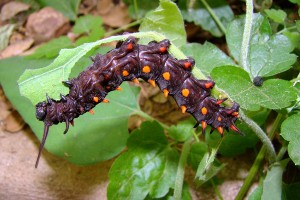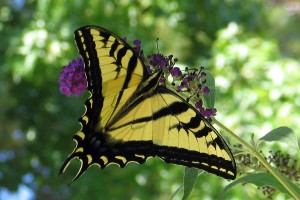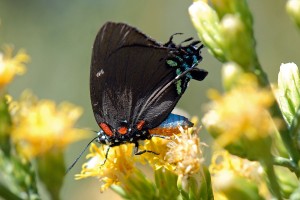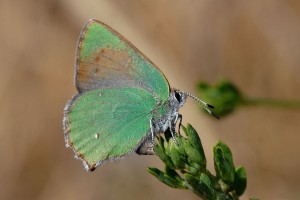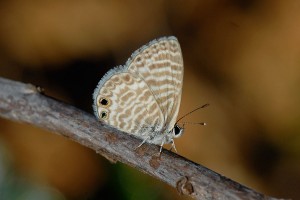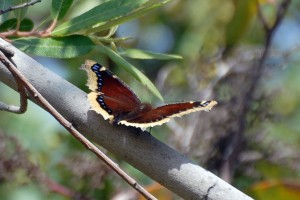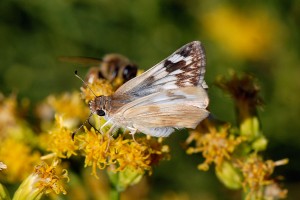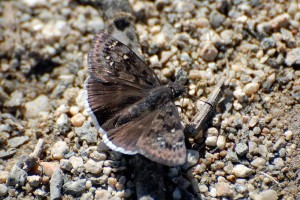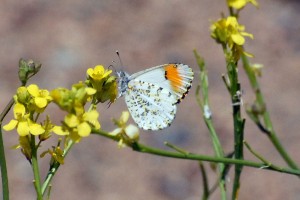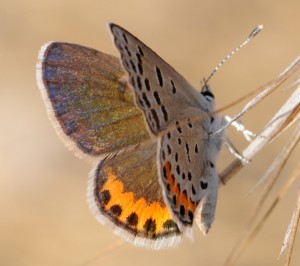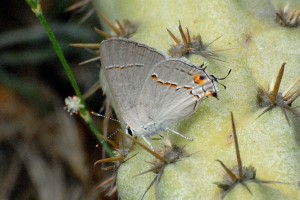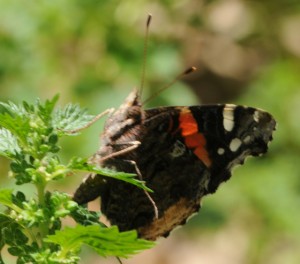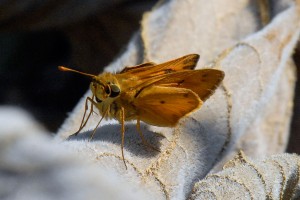In an earlier post reporting addition of nearly 100 new taxa to the BFS Invertebrate List, I mentioned that we’d feature some of them in future posts. Well, that number is now well over 100, but here’s a run-down on one group of new additions — butterflies…
So far in 2010 we’ve added nine new butterfly species:
-
Pipevine Swallowtail, Battus philenor
The Pipevine Swallowtail was featured in an earlier post, but now we have some photos of its very striking caterpillars: -
Pale Tiger Swallowtail, Papilio eurymedon
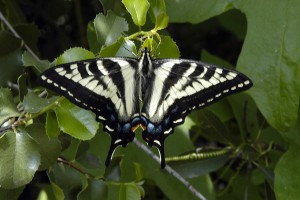
A Pale Tiger Swallowtail on Holly-leafed Cherry, Prunus ilicifolia ssp. ilicifolia at the BFS. Photographed by Tad Beckman.
Although this Pale Tiger Swallowtail was photographed in 2006, it hadn’t made it onto our list. The Pale Tiger Swallowtail is creamy white instead of yellow, and the tips of the forewings are quite pointed. It ranges throughout the Western US from British Columbia to Southern California. Adults nectar on a variety of flowers, and larvae eat foliage of a number of woody plants including California Coffee-berry (Rhamnus californica and Holly-leaved Cherry (Prunus ilicifolia) – where the one shown above was photographed.
-
Western Tiger Swallowtail, Papilio rutulus
The bright yellow and black Western Tiger Swallowtail is frequently seen around Claremont. The adults take nectar, and the larvae feed on foliage of deciduous trees, including willow and sycamore. With the abundance of sycamores as landscape trees in Claremont, Western Tiger Swallowtails are more common in the Village than at the field station, and we have yet to photograph one at the BFS.
-
Great Purple Hairstreak, Atlides halesus
With its brilliant orange and iridescent blue spots and body, the Great Purple Hairstreak is very striking even if it isn’t very purple and is only “Great” compared to other hairstreaks – it’s small compared to swallowtails. This butterfly’s range is the southern US, but it’s relatively rare in California – this sighting was only the second from California submitted to BugGuide. Adults take nectar, and larvae feed on mistletoe, live oak, and western sycamore.
-
Western Green Hairstreak, Callophrys affinis
The Western Green Hairstreak, Callophrys affinis, is native to the west; its range extends from southern British Columbia south to Mexico and east to Colorado. It’s mainly found in scrub and chaparral, where deerweed and buckwheat are its primary food plants.
-
Marine Blue, Leptotes marina
The Marine Blue is very common in Southern California. From there it ranges east through the Southwest, Mexico and Baja California to Guatemala. The caterpillars eat the buds, flowers, and seedpods of many legumes.
-
Mourning Cloak, Nymphalis antiopa
The Mourning Cloak is found throughout the US, but it’s more common in the West. Adults feed on tree sap, especially on oaks, and larvae feed primarily on willows, where this one was photographed.
-
Northern White Skipper, Heliopetes ericetorum
-
Mournful Duskywing, Erynnis tristis
The Mournful Duskywing, Erynnis tristis, is a southwest native, occurring from northern California south through central Arizona, southern New Mexico, and into Mexico and Central America. Its host plants are various oaks including coast live oak (Quercus agrifolia), and its preferred habitat is oak woodland.
The Northern White Skipper is found primarily in the American Southwest, but ranges north into Eastern Washington and south to Baja California. Adults take nectar from a variety of flowers, and larvae feed on various mallows including Sphaeralcea and Malva, where they take shelter in rolled leaves.
In addition, we now have photos of five species that were already on the list:
-
Sara Orange-Tip, Anthocharis sara
-
Acmon Blue, Plebejus acmon
-
Gray Hairstreak, Strymon melinus
-
Red Admiral, Vanessa atalanta
-
Fiery Skipper, Hylephila phyleus
Stay tuned for more updates on BFS Invertebrates!
